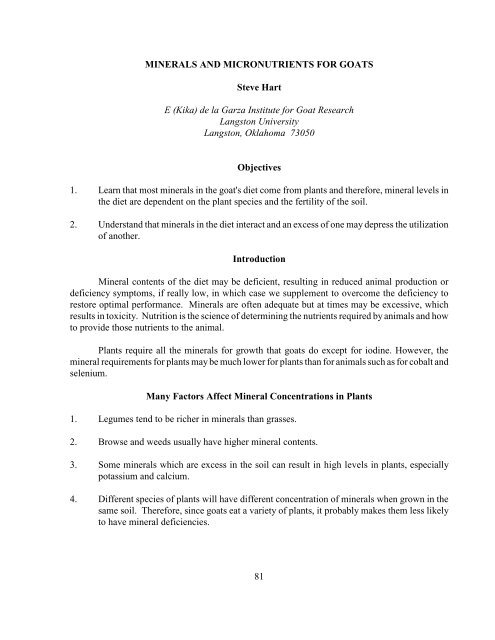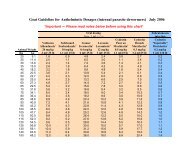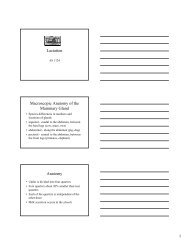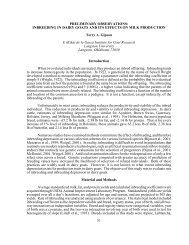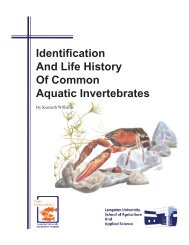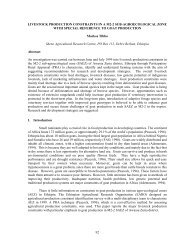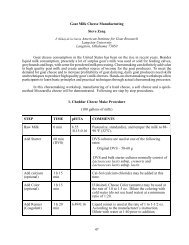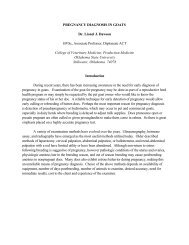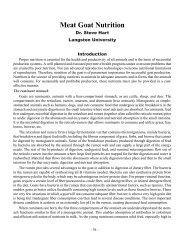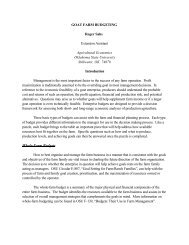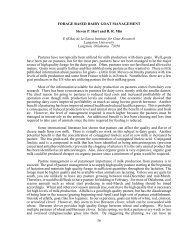81 MINERALS AND MICRONUTRIENTS FOR GOATS Steve Hart E ...
81 MINERALS AND MICRONUTRIENTS FOR GOATS Steve Hart E ...
81 MINERALS AND MICRONUTRIENTS FOR GOATS Steve Hart E ...
You also want an ePaper? Increase the reach of your titles
YUMPU automatically turns print PDFs into web optimized ePapers that Google loves.
<strong>MINERALS</strong> <strong>AND</strong> <strong>MICRONUTRIENTS</strong> <strong>FOR</strong> <strong>GOATS</strong><br />
<strong>Steve</strong> <strong>Hart</strong><br />
E (Kika) de la Garza Institute for Goat Research<br />
Langston University<br />
Langston, Oklahoma 73050<br />
Objectives<br />
1. Learn that most minerals in the goat's diet come from plants and therefore, mineral levels in<br />
the diet are dependent on the plant species and the fertility of the soil.<br />
2. Understand that minerals in the diet interact and an excess of one may depress the utilization<br />
of another.<br />
Introduction<br />
Mineral contents of the diet may be deficient, resulting in reduced animal production or<br />
deficiency symptoms, if really low, in which case we supplement to overcome the deficiency to<br />
restore optimal performance. Minerals are often adequate but at times may be excessive, which<br />
results in toxicity. Nutrition is the science of determining the nutrients required by animals and how<br />
to provide those nutrients to the animal.<br />
Plants require all the minerals for growth that goats do except for iodine. However, the<br />
mineral requirements for plants may be much lower for plants than for animals such as for cobalt and<br />
selenium.<br />
Many Factors Affect Mineral Concentrations in Plants<br />
1. Legumes tend to be richer in minerals than grasses.<br />
2. Browse and weeds usually have higher mineral contents.<br />
3. Some minerals which are excess in the soil can result in high levels in plants, especially<br />
potassium and calcium.<br />
4. Different species of plants will have different concentration of minerals when grown in the<br />
same soil. Therefore, since goats eat a variety of plants, it probably makes them less likely<br />
to have mineral deficiencies.<br />
<strong>81</strong>
5. Some soils are inherently deficient in some minerals due to parent material the soil was<br />
formed from, e.g., iodine and selenium.<br />
6. Plants grown on soils deficient in a mineral may be deficient in that mineral. Some plants<br />
however can concentrate available minerals.<br />
7. Phosphorus fertilizer reduces potassium in plants and potassium fertilizer reduces calcium<br />
content.<br />
8. Soil pH is a factor in that the farther from neutrality, trace mineral availability to the plants<br />
is reduced.<br />
9. Temperature-grass tetany, a deficiency symptom for magnesium, usually happens under cool<br />
soil temperatures which may reduce root uptake of magnesium.<br />
10. Seasonal variation, which may be an affect of maturity of the plants.<br />
Can analyze plants for mineral content, but you need to get a sample of what the goats are<br />
eating throughout the day and take several samples throughout the growing season. Is expensive and<br />
not likely worth the expense for most producers. Many state extension specialists know what<br />
minerals are likely to be deficient in given areas of their state i.e. Se, and I. Goats have similar<br />
mineral requirements to beef cattle.<br />
Macrominerals<br />
Macrominerals are required in fractions of percentages, and include calcium, phosphorus,<br />
sodium, potassium, chloride, sulfur, and magnesium<br />
Calcium 0.4%<br />
Biological function<br />
Bones-contain 99% of calcium in body<br />
Necessary for muscle contraction, nerve conduction, blood clotting<br />
Deficiency symptoms<br />
Rickets, bowing of limbs, lameness<br />
Vitamin D deficiency causes similar symptoms<br />
Urinary calculi if not 2:1 calcium to phosphorus ratio<br />
Toxicity - metabolic bone disease-bent legs<br />
Sources of calcium<br />
Legumes, limestone, bone meal, dicalcium phosphate<br />
82
Phosphorus<br />
Biological function<br />
Soft tissue and bone growth<br />
Energy metabolism and acid-base balance<br />
Deficiency<br />
Reduced growth, pica, decreased serum phosphorus<br />
Sources of phosphorus<br />
Protein supplements, cereal byproducts, mono and dicalcium phosphate<br />
Sodium 0.2%<br />
Potassium 0.8-2.0%<br />
Chloride 0.15%<br />
Biological function<br />
All three function as electrolytes in the body<br />
Lost in diarrhea<br />
Deficiency<br />
Potassium is deficient in high concentrate diets-poor appetite, urinary calculi,<br />
stiffness progressing from front to rear, pica<br />
Chloride deficiency depressed growth<br />
Sodium deficiency reduced growth and feed efficiency<br />
Sources<br />
Salt block, potassium is adequate in most forages<br />
Sulfur 0.2-0.32%<br />
Biological function<br />
Protein synthesis, including milk production and hair production Production of amino<br />
acids enzymes, hormones, hemoglobin, connective tissue, and vitamins<br />
Deficiency symptoms<br />
Poor performance, hair loss, excessive saliva, excess tearing of eyes, weakness<br />
Sources<br />
Protein therefore, may be a problem on NPN diets. Water can contain sulfur<br />
Sulfur blocks used for ticks<br />
83
Magnesium 0.18-0.4%<br />
Biological functions<br />
Proper function of nervous and muscular systems, enzyme systems<br />
Closely associated with metabolism of calcium and<br />
phosphorus. Essential component of bones and teeth<br />
Deficiency symptoms<br />
Death, loss of appetite, excitability, staggering, convulsions, deficiency on fast<br />
growing lush pasture, especially cool season grasses called grass tetany<br />
Sources<br />
Forages, magnesium oxide fed with protein supplement to prevent grass tetany<br />
Micro or Trace Elements<br />
Microminerals are required at the ppm level, and include iron, copper, cobalt, zinc, iodine,<br />
manganese, selenium, and molybdenum.<br />
Iron 50-1000 ppm<br />
Biological function<br />
Component of hemoglobin, required for oxygen transport<br />
Component of certain enzymes<br />
Deficiency symptom<br />
Anemia lack of hemoglobin (contains iron) Seldom deficient because of soil<br />
Sources<br />
Iron is stored in the liver, spleen and bone marrow<br />
Iron is very low in milk, kids raised for a long time on milk alone will develop<br />
anemia<br />
Copper<br />
10- 80 ppm<br />
Biological function<br />
Essential for formation of hemoglobin<br />
Component of enzymes<br />
Deficiency symptoms<br />
Anemia, rough "bleached coat", diarrhea and weight loss<br />
84
Toxicity<br />
Angora goats are sensitive, meat and dairy goats are similar to beef cattle<br />
Sources<br />
Forages, Grains, mineral supplements, trace mineralized salt, organic copper<br />
Cobalt<br />
0.1-10 ppm<br />
Biological function<br />
Essential for formation of vitamin B-12<br />
Rumen microbes utilize cobalt for growth<br />
Deficiency symptoms<br />
Loss of appetite, anemia, decreased production, weakness<br />
Sources<br />
Most natural feedstuffs<br />
Zinc<br />
40-500 ppm<br />
Biological function<br />
Found in all animal tissues<br />
Required for the immune system function<br />
Deficiency symptoms<br />
Dermatitis, thick dry patches of skint hair loss, lesions<br />
Swollen feet, poor hair growth,loss of hair<br />
Essential for male reproduction<br />
Sources<br />
Bran and germ of cereals<br />
Manganese<br />
40-1000 ppm<br />
Biological function<br />
Bone formation reproduction enzyme functioning<br />
Deficiency symptoms:<br />
Reluctance to walk, deformity of forelegs,<br />
Delayed onset of estrus, poor conception rate<br />
Low birth weight<br />
85
Source<br />
Difficult to get a deficiency<br />
Selenium<br />
0.2-3 ppm<br />
Biological function- requires vitamin E<br />
Reproduction<br />
Metabolism of copper, cadmium, mercury, sulfur, and vitamin E<br />
Deficiency symptoms<br />
Poor growth rate, kids unable to suck<br />
White muscle disease<br />
sudden death by heart attack progressive paralysis<br />
Retained afterbirth<br />
Toxicity in a few regions<br />
Shedding of hair, diarrhea, lameness<br />
Sources<br />
most plants which are not grown is selenium deficient soils<br />
Molybdenum 0.1-3 ppm<br />
Deficiency very rare<br />
Toxicity above 3 ppm due to reduced copper absorption<br />
Iodine<br />
0.5-50 ppm<br />
Biological function<br />
Formation of thyroid hormones which regulate energy metabolism<br />
Reproductive function<br />
Deficiency Symptoms<br />
Goiter-swelled or enlarged thyroid. Do not confuse with the thymus gland on young<br />
animals<br />
Reproductive problems-late term abortion, hairless fetus, weak kids<br />
Source<br />
Iodized salt<br />
86
Deficiencies or Toxicities<br />
Diagnosing mineral deficiency or toxicity - procedure used is dependent on which mineral<br />
you are looking at.<br />
1. Blood tests for some may be mineral level such as magnesium calcium or phosphorus or<br />
another factor in the blood such glutathione peroxidase for selenium, hemoglobin for iron,<br />
zinc binding protein for zinc, or thyroid hormones for iodine.<br />
2. Hair analysis has been used for zinc and Selenium<br />
3. Tissue tests such as liver for iron and copper<br />
4. Deficiency or toxicity symptoms are important-manganese and knuckling over.<br />
Summary<br />
Adequate levels of calcium and phosphorus in 2:1 ratio.<br />
Free-choice mineral supplements contain macrominerals, microminerals and vitamins<br />
Use trace mineralized salt if macrominerals are adequate.<br />
Avoid going overboard on any supplementation.<br />
Sources of mineral information<br />
Goat Medicine by Smith and Sherman<br />
Merck Veterinary Handbook<br />
State Livestock Extension Specialist<br />
87
The proper citation for this article is:<br />
<strong>Hart</strong>, S. 2003. Minerals and Micronutrients for Goats. Pages <strong>81</strong>-87 in Proc. 18th Ann.<br />
Goat Field Day, Langston University, Langston, OK.


